Everyone is familiar with Mycenaean Greece from Homer's epic poems the Illiad and the Odyssey, which are set in this period.
The Mycenaean era is a Bronze age era, which dated from about 1900 BC to 1100 BC.
We have only two sources of information about it - the archaelogical evidence and Homer's poems, which were written 500 years after this era, and mix in mythology about the gods with historical fact.
At the end of the Mycenaean period, Greece suddenly descended into a dark age (the citadels were abandoned and people took to the hills, we have no idea why, but think some calamity may have taken place). Greece comes out of the Dark Ages in about 800 BC, at which point Homer writes his epic down - and the classical period we are so familiar with begins. But the classical period continually harks back in it's literature and art to the Mycenaean Age which was regarded as a golden age of heroes.
This article looks at the archaeological record of the most important of the Mycenaean settlements, specifically the citadel of Mycenae, which is located in the northern part of the Peloponnese, near the modern day city of Argos.
Mycenae is important because the Greek alliance in the Trojan war was led by Agamemnon, King of Mycenae, and the shaft graves we will be looking at in some detail are very likely to belong to Agamemnon's family.
There were two main grave circles in the Mycenaean citadel - Grave Circle A and Grave circle B. They are known as "grave circles" because there is a circular wall enclosing the grave areas, which means they have their own delineated space within the citadel.
Grave circle A was first excavated in 1876 by Heinrich Schliemann (the same man who excavated Troy).
Grave circle A contained six shaft graves. Below we look at the goods found in shaft grave 4, which dates from 1600 BC to 1500 BC.
A shaft grave is a large rectangular grave, walled in with stone at the bottom, ten feet below the ground. Shaft grave 4 contained three men, two women and two children plus over 400 objects. We think this was the family tomb of the King because the goods in this shaft surpass anything in the other shaft graves.
Gold Death Masks of Mycenaean Kings
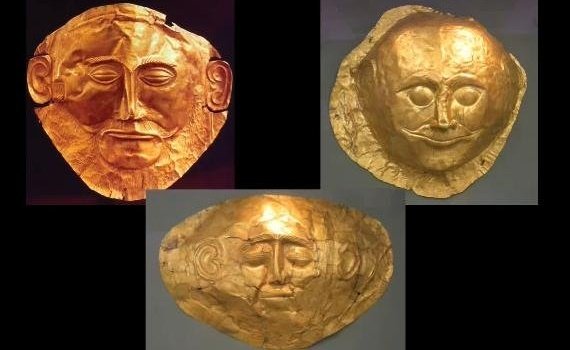
Heinrich Schliemann was convinced that the death mask on the top left (the bearded man) was Agamemnon, but it's possible that Agamemnon could be any of them.
What is clear is that these are not stylised images, the artist who made the masks was aiming for realism. Hence the mask on the top left shows a bearded man, while the other two are clean shaven, and the shapes of the noses and mouth are different in each case.
It's likely that the artist took a clay cast of the dead man, and then worked the gold into the clay mold produced, to make the mask. Certainly the man at the bottom looks to me like a middle aged man who is either asleep or dead - and his face looks serious and care-worn. Posed depictions of people tend not to show details like that. We also know from frescos and figurines found in the palace complexes that Mycenaean artists hadn't achieved any sort of true realism in their depictions of people (unlike in the later classical period) which means that the realism on these masks is almost certainly a result of taking a cast from the dead person.
Why did they do it? Probably because they knew the flesh would disintegrate in the grave and they wanted the departed to look like they did in life, thanks to the mask.
Gold bodysuits on the Mycenaean children
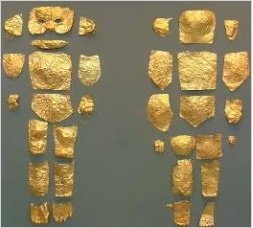
The two children in shaft grave 4 had gold "body suits" on them - see the image above.
The Mycenaeans had laid sheets of gold all over their bodies.
This again points to the fact that shaft grave 4 must have been a royal tomb and these must have been royal children - it's hard to imagine that ordinary children would have been laid out in this way.
Mycenaean Diadems
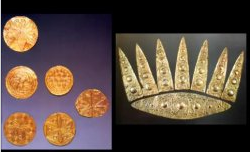
Eight gold diadems were found in Shaft grave 4 (one for each individual in the grave), along with 683 gold embossed discs.
We think that the gold discs were sewn onto the shroud that wrapped each person, which has been lost to time, leaving only the discs.
The Silver Siege Rhyton
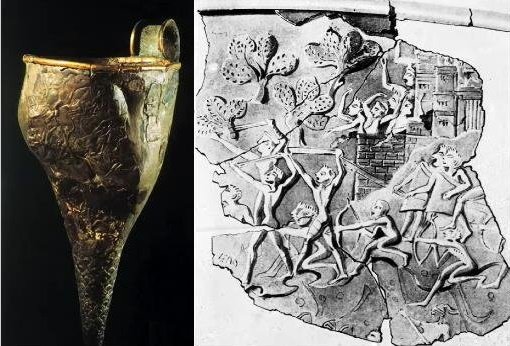
This drinking cup is called a rhyton and is made of silver.
Of particular interest is the scene depicted on it, which you can see in the image above. It looks like a depiction of the siege of Troy - you can see the women within the walls, and the men outside fighting.
What is truly interesting is that this is an image from around 1500 BC - i.e. at the time the Trojan war took place, whereas Homer's story was written some 500 years later. More proof that the battle of Troy did actually happen?
There are 38 figures on this cup.
Mycenaean vases
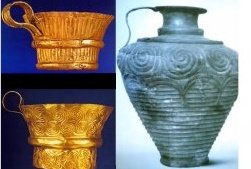
In the image above you see two gold cups and a silver vase.
There were a lot of vessels in Shaft Grave 4 - 11 silver vases, 5 gold vases, 22 bronze vases, 8 clay vases, 2 gold rhytons, 3 silver rhytons, and 2 oyster shell rhytons (which were probably imported).
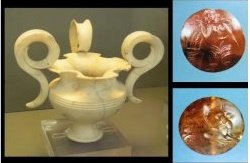
In Shaft Grave 4 you also get the alabastor vase shown above, which has been imported from Egypt, plus the amber seals (the amber has been imported from northern Europe and then the art-work has been added in Mycenae).
Mycenaean Daggers
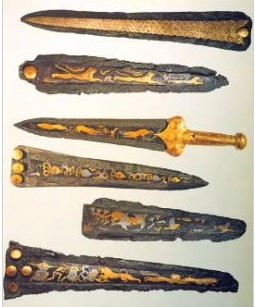
There was a lot of weaponry in Shaft Grave 4 - 27 swords, 16 pomels (sheaths that housed the weapons), 38 arrow heads, 16 knives, 5 daggers, an axe and two weapon sharpeners.
Above you see some of the daggers. They are made of bronze using a technique known as niello. After the bronze is cast, a section down the center is cut out. Then figures made of gold, silver and electrum are made and hammered into that area. Metal is placed next to the figures to act as a solder and the dagger is then put into a furnace to set it and it is then polished.
It's likely these daggers were just decorative and not actually used.
Mycenaean Signet Rings
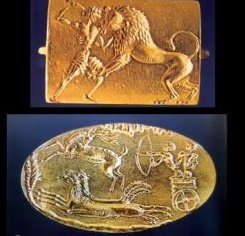
The two rings shown above are enlarged images of signet rings found in Shaft Grave 4, which show hunt scenes - the image on the bottom shows men in chariots hunting stags.
With the top image of a man fighting a lion - it looks like a scene from the Mesopotamian Gilgamesh - which may indicate that the ring has been imported. Certainly the man at the top looks to be wearing trousers, a Mesopotamian practice - the Greeks liked to show their men nude.
Conclusion
The reason we are so fascinated with the treasures from this grave is not just because they are nearly 4000 years old. It is because these people inspired the classical greeks, who in turn laid the foundations for our civilization. Most of this treasure is displayed in the National Archaeological Museum in Athens and I thoroughly recommend a visit.
I wonder where they imported the gold from - I don't think you can mine gold in Greece.
Downvoting a post can decrease pending rewards and make it less visible. Common reasons:
Submit
It is strange looking at a death mask and thinking you are seeing a face from nearly 4000 years ago...
Downvoting a post can decrease pending rewards and make it less visible. Common reasons:
Submit
Congratulations @candy49! You have completed some achievement on Steemit and have been rewarded with new badge(s) :
Click on any badge to view your own Board of Honnor on SteemitBoard.
For more information about SteemitBoard, click here
If you no longer want to receive notifications, reply to this comment with the word
STOPBy upvoting this notification, you can help all Steemit users. Learn how here!
Downvoting a post can decrease pending rewards and make it less visible. Common reasons:
Submit
Congratulations @candy49! You have received a personal award!
Click on the badge to view your own Board of Honor on SteemitBoard.
For more information about this award, click here
Downvoting a post can decrease pending rewards and make it less visible. Common reasons:
Submit